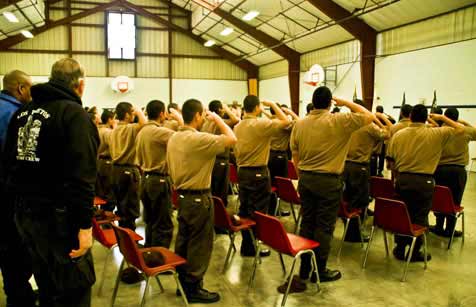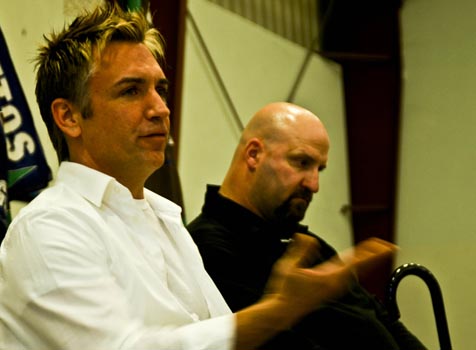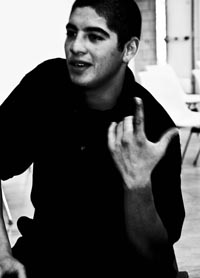Museum of Tolerance Speakers Address Youth at Los Prietos Boys’ Camp
From Hate to Hope

In times of escalating gang violence and racial tension here in Santa Barbara, those working to prevent these trends often try to find its source. The effort to quell this rage before it starts prompted the Simon Wiesenthal Museum of Tolerance to send speakers to the Los Prietos Boys’ Camp on March 9. Nearly 100 boys listened intently to the stories of Tim Zaal, a former neo-Nazi, and Matthew Boger, who as a teen had been kicked out of his house by his mother for being a homosexual.
Dressed in crisply ironed trousers and spit-shined combat boots, the campers marched into the meeting room, followed by their honor guard bearing the national, state, and camp colors. Zaal began his story, which starts with a relatively normal upbringing in a Los Angeles suburb during the late 1960s. The gradual introduction of minorities into his neighborhood changed things, Zaal recalled. Friends and family commented on the changing demographic. “I didn’t become racist overnight,” he said. “I lived in one of those neighborhoods where everything was perfect. At some point, that image of perfection was threatened by incoming diversity-mostly Hispanic. I remember my dad saying things like, ‘The property values are going down. The neighborhood isn’t what it used to be.'” Eventually, his family moved to a more affluent suburb that was closer to the “perfect” ideal they had earlier in the old neighborhood. Zaal described how his brother, the rebel in the family and someone to whom he looked up, kept hanging out in the old neighborhood and running around with the “wrong crowd.” “He had tattoos and drove a loud motorcycle and had long hair,” he said. “He worried a lot of the neighbors [in the new neighborhood].”

Zaal’s opinion about minorities was cemented the day his brother, who he was sure was involved in some sort of drug activity, was shot in the heart by an African-American man. “From that day forward, whenever I thought of an African American, I thought of that gunman,” he said. “I didn’t think of him as one guy. I thought they were responsible.” While Zaal’s brother survived, Tim Zaal’s hatred for minorities continued to grow, and it meshed all too well with the rising punk rock scene of the late 1970s. “It wasn’t like the punk rockers running around today with all of the vegetarians and peace punk and all that. We were carnivorous, and we were violent.” Indeed they were. Zaal told of how they used to put razor blades in the tips of their shoes and get into fights at concerts. Charged up on the thrill of violence, Zaal and his friends used to drive around after shows “handing out slaps,” or looking for people to beat up. “It was after one of these shows that we kept circling a certain hotdog stand, and it got really violent. I kicked some guy in the head and left him for dead.”
Boger’s story offered the Los Prietos youths a different perspective. Growing up in a Bay Area suburb, he was one of seven children born to a convent teacher who married a member of the Hell’s Angels motorcycle gang. His father continued riding with the Hell’s Angels, leading to a divorce in which his mother assumed custody of Boger and his siblings. “I was different from my brothers,” he said. “I was that skinny, quiet kid that got his ass kicked a lot. I didn’t know what made me different.” When he was 12 years old, Boger visited San Francisco’s Castro District for the first time. “I felt like a complete person and was finally able to identify that I was gay. I also knew that I couldn’t tell my family.” A full year passed before Boger could summon up the courage to call a family meeting to tell his parents that he was gay. His mother packed a bag with some clothes and told him to leave. “At 13 years old, I was living on the streets in San Francisco,” he said. “I had been living in the streets for about six months when I was picked up by the police for being out after curfew. The police officer called my mother and had her on speakerphone. When he asked my mother what she wanted to do, I heard her say, ‘I don’t care. I don’t want him. You can do what you want with him.’ The policeman looked at me and said, ‘I’m really sorry. Good luck out there.'”
Boger then decided to move to Los Angeles, where a loose-knit community of individuals like himself scratched out a meager existence in a park. He was repeatedly victimized. “Every night, we would all meet at this hot dog stand, just to make sure everyone was still alive. One night, someone in a big gang of guys yelled, ‘All fags die!’ I started running, but I didn’t make it. I fell down and they started kicking me. They had razor blades in their boots. One even hit me in the forehead and cut my face open.” Boger survived the attack, but lived his life in fear. It wasn’t until the 1998 hate-based killing of gay University of Wyoming student Matthew Shepherd that he decided to stand up and be heard. “The only difference between him and me was that he was dead and didn’t have a voice.” Although he never had an opportunity to advance past the seventh grade, Boger’s dedication to activism landed him an internship with the Museum of Tolerance, where he eventually became the director.
Working for the museum, Boger was put in touch with Zaal, who had by then had children and had come to the realization that his hatred greatly impacted his kids’ behavior and ideas. The two sat together at a restaurant, sharing past experiences, when they realized that Zaal was the one who had split open Boger’s face with a deftly aimed blow from a razor-tipped boot. “At that point, I just shut down,” Boger said. He only knew the past was past when Zaal formally apologized to him in front of a group of people. Now, the two tour together, spreading their experience-laden message of tolerance. “He’s like the big brother I never had,” said Boger. “Forgiving him was a big part of me being able to forgive my mother when I went to her funeral [a couple of years ago].”
The main message that the unlikely duo had for Los Prietos campers-many of whom have been involved in gang-related interracial violence-was to look past differences and see people as human beings. “I think it takes a very big man to forgive someone like me,” Zaal said, in reference to his attack on Boger 26 years ago. Zaal also encouraged the teens to get out of the social circles that had landed them at Los Prietos and keep away. “Just like a dope fiend or an alcoholic, you need to stay away from people who are [engaged in that behavior].”
The Los Prietos Boys’ Camp has been in operation for more than 60 years as a place where boys 14-18 years old can escape continuing down “the wrong path” with a very structured program of high school classes, physical exercise, and job training programs. Younger boys who have perpetrated lesser crimes don the brown uniforms of the Los Prietos Boys Academy-a 120-day course. Older boys with more complicated criminal records dress in the blue uniforms of the Los Prietos Boys’ Camp-a 180-day course. According to probation supervisor Nancy Taylora, some boys’ stays may be longer or shorter depending upon behavior, with some stays lasting for more than a year. Because the camp is situated on National Forest property, those convicted of violent crimes are not allowed to attend.

A group of the older boys discussed their thoughts on gangs and the messages given by Boger and Zaal. “I joined a gang and used to fight people for no reason and beat them up just because of their skin color,” said 18-year-old Ivan Arteaga. “In camp, I’ve changed my ways and don’t want my family to get hurt because of my actions.” Juan Arevalos, 18, was placed in Los Prietos Boys’ Camp for drug use and probation violations. His advice for how to stop gang violence: “Reach out to kids.”
The programs available at Los Prietos, designed to keep the boys busy at all times, include forestry programs and other job-training opportunities. “The goal is to plug [the campers] into jobs and get them into school, because while they’re here, they thrive on structure,” Taylor said. “After they get out, the more they can stay busy, the better the chance for success. We try to get a lot of our kids into [military] recruiting offices, but because of the nature of some of their crimes, it can be difficult.”
This year, on May 14, 21 of the boys from the camp will be graduating from high school. “We’re very excited about it,” Taylor said.



